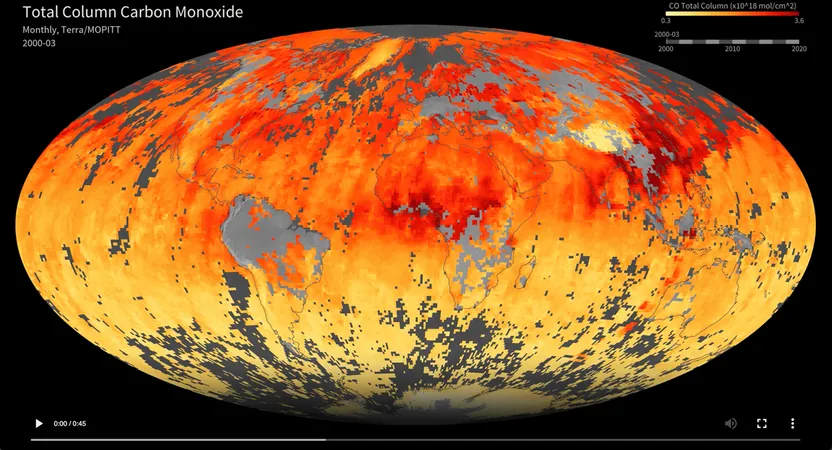
NASA’s Earth Missions: A Legacy of Innovation and Change
2025-06-11
Author: Jacques
NASA’s Resilient Earth Operations
NASA's Earth science missions have shown exceptional resilience and innovation over the years, navigating the transition from longstanding satellites to state-of-the-art technologies. The cornerstone of these efforts has been the Terra platform, which has been gathering critical data from space since December 1999. Remarkably, four of its five instruments are still operational, contributing invaluable information to our understanding of our planet, despite facing power supply issues.
Terra’s Power Challenges
Recent challenges have arisen due to Terra's power supply, exacerbated by orbital changes and the performance of solar arrays. A significant event occurred on November 28, 2024, when one of Terra's power-shunting units failed. In response, a team of experts swiftly adapted the spacecraft's operations, adjusting the battery charge rate and reducing power consumption by putting the Advanced Spaceborne Thermal Emission and Reflection Radiometer (ASTER) into a safe mode.
End of an Era: MOPITT’s Achievements
Regrettably, the Measurement of Pollution in the Troposphere (MOPITT) instrument was put into safe mode on February 4, 2025, and was finally shut down on April 9, 2025, after 25 years of groundbreaking work as Canada’s contribution to monitoring air quality from space. Known as the longest-running air quality satellite, MOPITT’s data was vital for tracking carbon monoxide distribution, pollution sources, and emissions, greatly influencing climate research and policy globally. To celebrate its legacy, the team held a fitting 25th anniversary event just days after its shutdown, showcasing MOPITT’s remarkable contributions.
Innovative Successor: The TROPICS Mission
As MOPITT retired, exciting new projects like the TROPICS mission emerged to advance Earth observation. Launched in May 2023, TROPICS employs a unique constellation of CubeSats to gather real-time data on tropical cyclone structure and precipitation. Its innovative approach allows for hourly updates on storm activity, significantly enhancing forecasting accuracy and supporting disaster response efforts.
ICESat-2: Pioneering Earth Observations
Another trailblazing mission is NASA's ICESat-2, which continues to push the boundaries of Earth observation. By March 2025, it achieved a remarkable milestone by firing its two trillionth laser pulse, providing invaluable insights into changing ice conditions. The mission's advanced technology has made it crucial for mapping the consequences of climate change and for coastal management strategies.
SAGE III/ISS: Enhancing Atmospheric Research
Taking atmospheric science to new heights is NASA's SAGE III mission aboard the International Space Station. As of early 2025, this mission continues to refine our understanding of the Earth’s atmosphere, launching new tools to improve data accessibility and analytics for scientists worldwide.
Honoring the Contributions of Key Figures
In the spirit of change and legacy, we remember Dr. Stanley Sander, who passed away in March 2025, leaving behind a monumental impact on atmospheric research. Conversely, we celebrate the retirement of Jack Kaye after 42 years of service, whose leadership and kind mentorship shaped the future of Earth science at NASA. Both figures exemplify the dedication and innovation at the heart of NASA's mission.
The Future of Earth Missions Awaits
With each mission, both retired and ongoing, NASA underscores its commitment to understanding our planet through cutting-edge technology and international collaboration. As we look ahead, the stage is set for the next generation of Earth observation missions to carry forward this vital scientific exploration.









 Brasil (PT)
Brasil (PT)
 Canada (EN)
Canada (EN)
 Chile (ES)
Chile (ES)
 Česko (CS)
Česko (CS)
 대한민국 (KO)
대한민국 (KO)
 España (ES)
España (ES)
 France (FR)
France (FR)
 Hong Kong (EN)
Hong Kong (EN)
 Italia (IT)
Italia (IT)
 日本 (JA)
日本 (JA)
 Magyarország (HU)
Magyarország (HU)
 Norge (NO)
Norge (NO)
 Polska (PL)
Polska (PL)
 Schweiz (DE)
Schweiz (DE)
 Singapore (EN)
Singapore (EN)
 Sverige (SV)
Sverige (SV)
 Suomi (FI)
Suomi (FI)
 Türkiye (TR)
Türkiye (TR)
 الإمارات العربية المتحدة (AR)
الإمارات العربية المتحدة (AR)